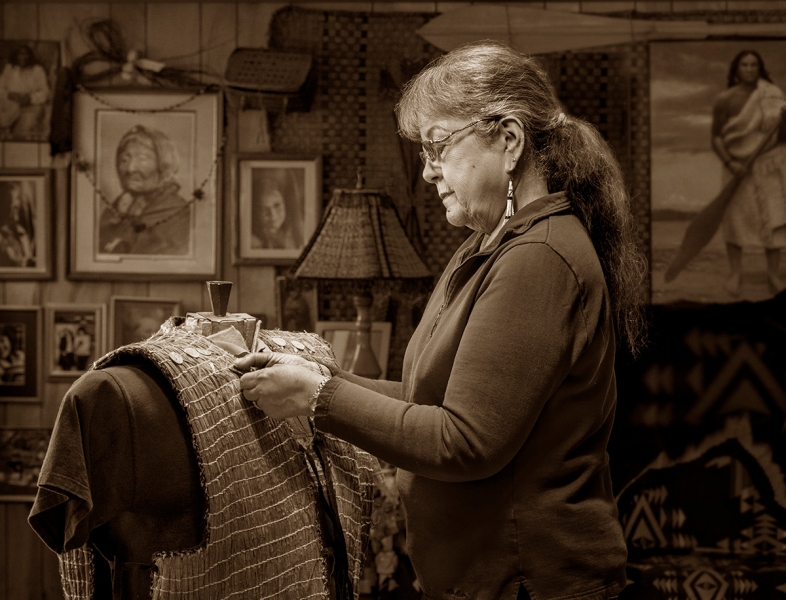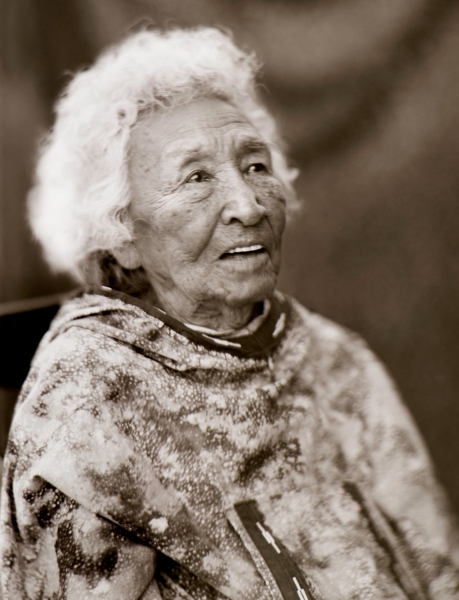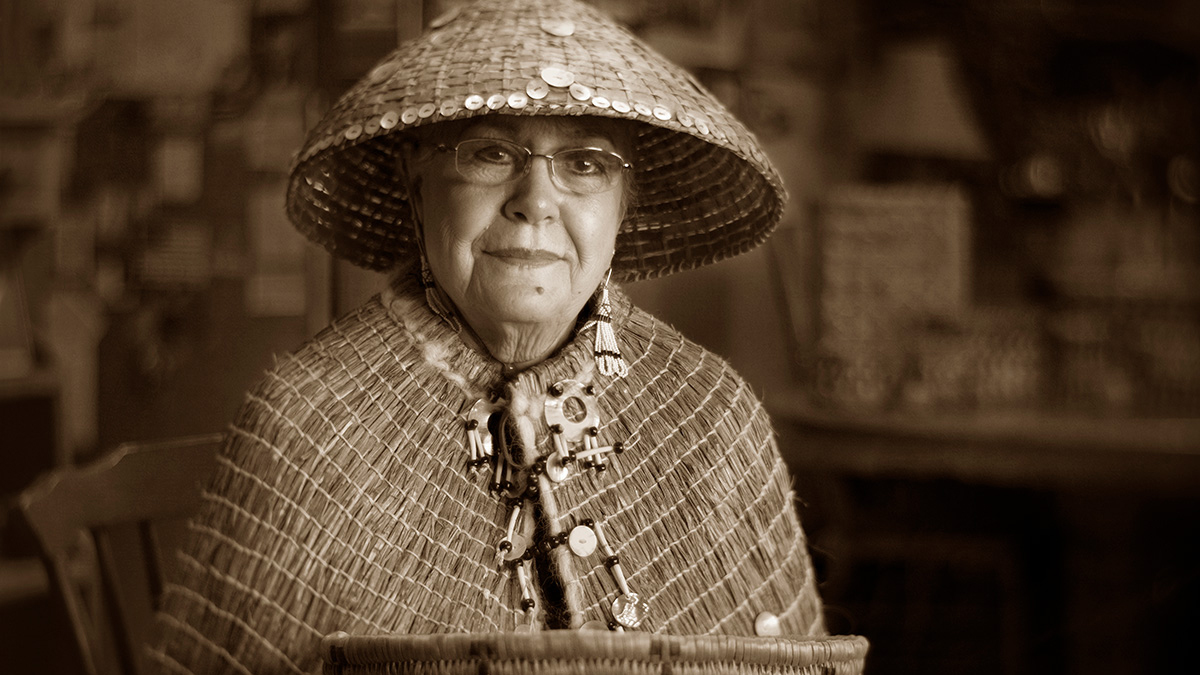John and Coleen Graybill revisit an ancestor’s passion project
Photographers John and Coleen Graybill discuss their "Descendants Project," which revisits Edward S. Curtis' portraits of Native Americans
• April 2019 issue
Mary Lou Slaughter was a schoolgirl in Seattle when her teacher mentioned a photograph of Mary Lou and her Native American grandmother that was displayed at the county fair. Learning of her heritage, classmates of Mary Lou subjected her to name-calling, spittle, and bullying for being a “dirty old Indian.” Slaughter shunned her heritage until, at 50, she witnessed her son’s talent for wood carving. Embracing her indigenous background, Slaughter became a master basket weaver. Now 80 years old, she still harvests cedar bark to transform into clothing.

A recent portrait of Slaughter (right) shows her sewing a cedar bark vest. On the wall behind her is a portrait of Si’ahl, a mid-19th century leader of the Suquamish and Duwamish peoples and, his name anglicized as Chief Seattle, the namesake of Slaughter’s city. Also in the image is a portrait of Si’ahl’s daughter, Princess Angeline, the first in a series of Native American portraits made by photographer Edward S. Curtis. The image of Slaughter, the great-great-great-granddaughter of Angeline, was captured by the great-grandson of Curtis, John Graybill. It’s the first of many Native American portraits Graybill and his wife, Coleen, plan to make.
For their Descendants Project, the Graybills intend to photograph descendants of Native Americans profiled by Curtis in “The North American Indian,” his 20-volume encyclopedia of indigenous culture. Curtis spent more than 30 years visiting some 80 tribes, recording their rituals and arts and producing more than 40,000 photographic images. Thanks to the Curtis legacy, locating the descendants has been easy. Working out the technical issues of reproducing the look of Curtis’ images, funding the project, and overcoming family reticence have been the challenges.
Long time coming

Princess Angeline, captured in the early 20th century
Born in 1957, five years after Curtis died, John grew up with Curtis’ work on the walls of his Connecticut home. “It was no big deal—everyday stuff,” he says. The big deal was finding in the basement a box of his father’s old photographic gear. “I took the camera upstairs and asked if I could use it. I was off and running.” He’d turn the family kitchen into a darkroom after dinner, participated in a fifth grade photography club, and by high school he was making color prints in the darkroom as a yearbook photographer. He initially attended Ohio University and then the Rhode Island School of Photography in Providence. Nevertheless, he ended up working as an auto mechanic, first in Colorado Springs and then in Seattle, photographing only as a hobby. After 29 years as a mechanic, he began making portraits and photographing weddings professionally. He moved back to Colorado, retired to Buena Vista, and switched to landscape and wildlife photography. There he met Coleen.
When Coleen had been a student at Central Michigan University, two of her roomates, one a journalism major with a camera, took a road trip and came back with pictures. One was a portrait of the other roommate. “It was intriguing to me that a photograph could tell you everything you needed to know about a person,” says Coleen, who’s been shooting professionally since 1990. Her work includes weddings and environmental portraits, a specialty she began after moving to Colorado Springs. “I loved having this beautiful landscape with a person in it for the scale and the point of interest,” she says.
Three years ago, she moved to Buena Vista and was introduced to John. They married and formed Mountain Spirit Photography, which specializes in photographs of the surrounding landscape. These they post electronically on their website and physically on the wall of Simple Eatery in downtown Buena Vista, a popular spot for tourists, who see the images, visit the website, and order prints.
Revisiting an old project

Family of the Inupiag tribe from Noatak, Alaska, captured in the early 20th century. At the center is 4-year-old Anna Ellis.
A longtime member of local PPA affiliates, Coleen mentioned to the president of the Professional Photographers Guild of Colorado Springs that she was married to the great-grandson of Edward Curtis, which led to an invitation for John to do a presentation on Curtis. Studying for his talk, John gained a deep appreciation of his ancestor’s work. That plus a standing ovation from the 45 attendees inspired him and Coleen to build upon Curtis’ photography. The only deterrent was John’s father. “He was adamant about people not profiting off great-grandfather’s work because Curtis never made money on it.”
The Graybills decided to link their effort to the purpose of Curtis’ work, which won over John’s family. Curtis captured images of people and their cultures, thought to be “vanishing,” titling one of his iconic works “Vanishing Race.” The use of “vanishing” in this context has taken on racist overtones, defined as a white-dominated society’s attempt to romanticize populations and cultures that it was systematically exterminating. Too, indigenous people didn’t vanish; they were forced into cultural assimilation or onto impoverished reservations. Curtis in his time championed the heritage of indigenous peoples of North America, not just through his images but with accompanying texts recording tribal culture.
Just as his images tell the story of indigenous peoples in early 20th-century America, the Graybills seek to tell the story of indigenous peoples in early 21st-century America. “That’s what it’s gelled into today, the relationship between the descendants and their ancestors, what it meant to them to see Curtis’ imagery,” John says. “What’s happened to the family since then,” Coleen adds.

A contemporary portrait of Anna Ellis, whom Edward Curtis photographed at age 4 (see above)
The Graybills’ images will not mirror Curtis’; the descendants are being portrayed in their own environments. “The whole project is about telling the descendants’ stories about who they are and why they are,” Coleen says. “Which is basically what Curtis did. He got the information, he got the stories, and then he photographed them. That’s what we’re doing now.” For the Graybills’ second portrait subject, Jacqueline Ellis of Colorado Springs, her family’s story involved multigenerational alcoholism, which can be traced to the conflict with white culture. In one image, the mother has her arms around her three children. “She’s a protector of her children going into this world,” John says.
The sepia tone of the images resembles that of Curtis’ work—intended both for legacy and aesthetics. “In continuing his legacy about Natives and who they are today, it was important to me that the images we create have a similar look and feel. If I look at a color photograph, I see color. If I look at a black-and-white or a sepia image, I’m not distracted by color: I see the image,” says John.
Getting that look was the project’s first real challenge. They experimented with digital cameras, but the sharp images didn’t seem right. “It’s too much,” John says. “For the work we’re doing, I find it a distraction, especially compared to what Curtis was doing.” Curtis used a Petzval lens, and John found a digital version of a Petzval made by a Russian company. He attached it to his Nikon D850 for the Slaughter portraits, but the digital effects were still in play. “It’s capturing a lot of detail.”
They then decided to fully replicate the technology Curtis used by purchasing a Chamonix View Camera shooting 6.5x8.5 dry plate and an 1860 Petzval lens with a fixed f/5.6 aperture. They designed a tent studio based on what Curtis used, cutting a hole into the canvas to produce a single light source. This makeshift studio debuted in their second portrait session, with a translucent panel replacing one wall of the tent. “It was more of a huge softbox,” Coleen says. The extra light allowed a faster shutter speed needed to accommodate a 9-month-old infant who couldn’t keep still for what otherwise would be a 15-second exposure. John digitizes the glass plates by shooting the images with his Nikon D850 and a 105mm macro lens.

Jacqueline Ellis is the granddaughter of Anna Ellis
They like the results but still have much to learn about the right amount and positioning of light. “We’re so used to looking at an image and deciphering based on our digital background,” John says. “I’m having to relearn images based on film capture.” They’ve had time to practice while they lined up a nonprofit and financing for the project.
“It’s ironic that I find myself in a similar situation as my great-grandfather. He struggled with funding for his project from day one. He had to keep pushing forward because, with the passing of each elder, stories were being lost for all time. We find ourselves in a similar position. We have descendants at age 94, so we can’t waste time.” Actually, that 94-year-old, Anna Ellis, is not a descendant: She was 4 years old when Curtis photographed her. She’s the grandmother of Jacqueline Ellis of Colorado Springs.
Connecting with the descendants has been the easiest aspect of the project; just mentioning the idea around town yielded the Ellis family. Making connections with Curtis biographers and exhibitors has led to other subjects, and those subjects connect them with more. Coleen has begun introducing the project to Native American communities online where Curtis is considered a hero. “He not only photographed Native Americans, he wrote about their lore, their spirituality, their crafts, their culture, their songs, their language,” Coleen says. Curtis gave indigenous people today the means to discover their own tribal heritage.
Eric Minton is a writer and editor in Washington, D.C.


 View Gallery
View Gallery


